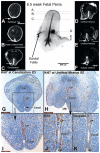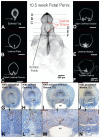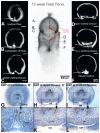Canalization of the urethral plate precedes fusion of the urethral folds during male penile urethral development: the double zipper hypothesis
- PMID: 25286011
- PMCID: PMC4456085
- DOI: 10.1016/j.juro.2014.09.108
Canalization of the urethral plate precedes fusion of the urethral folds during male penile urethral development: the double zipper hypothesis
Abstract
Purpose: We describe the "double zipper" mechanism of human male urethral formation, where the distal zipper opens the urethral groove through canalization of the urethral plate, and a second closing zipper follows behind and closes the urethral groove to form the tubular urethra.
Materials and methods: Anonymous human fetal genital specimens were acquired and gender was determined by polymerase chain reaction of the Y chromosome. Specimens were processed for optical projection tomography, stained with E-cadherin, Ki67 and caspase 3, and imaged.
Results: Eight developing male fetal specimens from 6.5 to 16.5 weeks of gestation were analyzed by optical projection tomography, and an additional 5 specimens by serial sections. Phallus length ranged from 1.3 to 3.7 mm. The urethral plate canalized into a groove with 2 epithelial edges that subsequently fused. Ki67 staining was localized to the dorsal aspect of the urethral plate. In contrast, caspase 3 staining was not observed. The entire process was completed during a 10-week period.
Conclusions: The human male urethra appears to form by 2 mechanisms, an initial "opening zipper" that facilitates distal canalization of the solid urethral plate to form the urethral groove, which involves a high rate of epithelial proliferation (apoptosis not observed), and a "closing zipper" facilitating fusion of the 2 epithelial surfaces of the urethral groove, and thus extending the penile urethra distally. Improved knowledge of the molecular mechanisms of these processes is critical to understanding mechanisms of abnormal urethral development, such as hypospadias.
Keywords: growth and development; hypospadias; organogenesis; urethra.
Copyright © 2015 American Urological Association Education and Research, Inc. Published by Elsevier Inc. All rights reserved.
Figures








Comment in
-
Editorial comment.J Urol. 2015 Apr;193(4):1359-60. doi: 10.1016/j.juro.2014.09.128. Epub 2014 Dec 26. J Urol. 2015. PMID: 25545422 No abstract available.
References
-
- Baskin LS, Ebbers MB. Hypospadias: anatomy, etiology, and technique. J Pediatr Surg. 2006;41:463. - PubMed
-
- Glenister TW. A correlation of the normal and abnormal development of the penile urethra and of the infra-umbilical abdominal wall. Br J Urol. 1958;30:117. - PubMed
-
- Kurzrock EA, Baskin LS, Cunha GR. Ontogeny of the male urethra: theory of endodermal differentiation. Differentiation. 1999;64:115. - PubMed
-
- Baskin LS. Hypospadias and urethral development. J Urol. 2000;163:951. - PubMed
-
- Baskin LS, Erol A, Jegatheesan P, et al. Urethral seam formation and hypospadias. Cell Tissue Res. 2001;305:379. - PubMed
Publication types
MeSH terms
Grants and funding
LinkOut - more resources
Full Text Sources
Other Literature Sources
Research Materials

